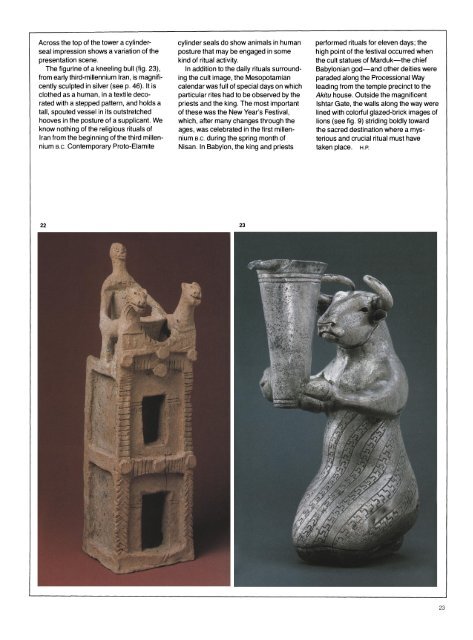Ancient Near Eastern Art: The Metropolitan Museum of Art Bulletin, v ...
Ancient Near Eastern Art: The Metropolitan Museum of Art Bulletin, v ...
Ancient Near Eastern Art: The Metropolitan Museum of Art Bulletin, v ...
Create successful ePaper yourself
Turn your PDF publications into a flip-book with our unique Google optimized e-Paper software.
Across the top <strong>of</strong> the tower a cylinderseal<br />
impression shows a variation <strong>of</strong> the<br />
presentation scene.<br />
<strong>The</strong> figurine <strong>of</strong> a kneeling bull (fig. 23),<br />
from early third-millennium Iran, is magnificently<br />
sculpted in silver (see p. 46). It is<br />
clothed as a human, in a textile decorated<br />
with a stepped pattern, and holds a<br />
tall, spouted vessel in its outstretched<br />
hooves in the posture <strong>of</strong> a supplicant. We<br />
know nothing <strong>of</strong> the religious rituals <strong>of</strong><br />
Iran from the beginning <strong>of</strong> the third millennium<br />
B.C. Contemporary Proto-Elamite<br />
cylinder seals do show animals in human<br />
posture that may be engaged in some<br />
kind <strong>of</strong> ritual activity.<br />
In addition to the daily rituals surrounding<br />
the cult image, the Mesopotamian<br />
calendar was full <strong>of</strong> special days on which<br />
particularites had to be observed by the<br />
priests and the king. <strong>The</strong> most important<br />
<strong>of</strong> these was the New Year's Festival,<br />
which, after many changes through the<br />
ages, was celebrated in the first millennium<br />
B.C. during the spring month <strong>of</strong><br />
Nisan. In Babylon, the king and priests<br />
performed rituals for eleven days; the<br />
high point <strong>of</strong> the festival occurred when<br />
the cult statues <strong>of</strong> Marduk-the chief<br />
Babylonian god-and other deities were<br />
paraded along the Processional Way<br />
leading from the temple precinct to the<br />
Akitu house. Outside the magnificent<br />
Ishtar Gate, the walls along the way were<br />
lined with colorful glazed-brick images <strong>of</strong><br />
lions (see fig. 9) striding boldly toward<br />
the sacred destination where a mysterious<br />
and crucial ritual must have<br />
taken place. H.P.<br />
22 23<br />
23

















